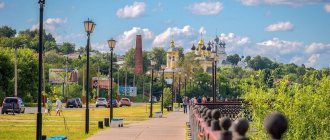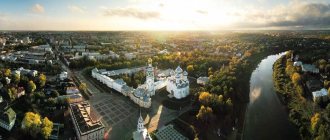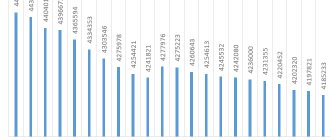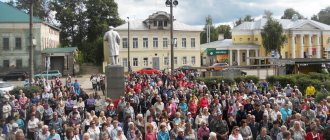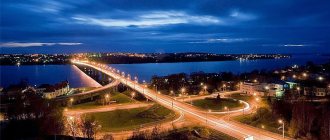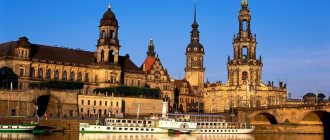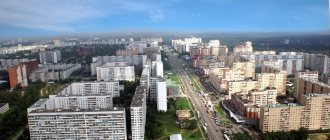Who hasn't heard of Yaroslavl! And I know him firsthand. I've been there more than once, and I adore this city. I just love to walk along it and look at it.
After all, this is one of our oldest Russian cities (so ancient that it remembers the invasion of the Tatar-Mongols ). It is part of the Golden Ring of Russia (it even claims to be the capital of this ring). Named in honor of its founder – Yaroslav the Wise. Very beautiful, with many temples, bell towers, interesting buildings, monuments, parks ... The embankment there is amazing , large, with viewing gazebos and linden trees.
huge have been shot in Yaroslavl :
- "Crew";
- "Big change";
- "Yesenin";
- “Afonya” (there is even a monument to the film);
- "Palmist";
- "Kotovsky".
It’s impossible to list everything!
In my city there is no such architectural and historical wealth, so I walk around Yaroslavl with my mouth open: I like everything there!
What holiday is it today?
February 10, 2022, Thursday
Today are holidays, events: Diplomat's Day Tomorrow: World Sick Day Discovery of insulin
Today is the Orthodox holiday: St. Ephraim the Syrian. Venerable Ephraim of Novotorzhsky. Venerable Ephraim of Pechersk, Bishop of Pereyaslavl. Venerable Theodosius of Totem, Spasosumorin of the monastery, leader and founder... Tomorrow: Transfer of the relics of the holy martyr Ignatius the God-Bearer. Saints Gerasim, Pitirim, Jonah, bishops of Great Perm, Ustva...
Today is a national holiday: Ephraim's Day... Tomorrow: Lawrence's Day
Seasons
Seasons, four periods of the year (spring, summer, autumn and winter) characterized by certain average temperatures. The period during which the Sun passes through one of these sectors is called the season. Spring in the Northern Hemisphere and autumn in the Southern Hemisphere begin when the Sun passes through the initial circle of declination and its right ascension is 0° (vernal equinox). Summer in the Northern Hemisphere and winter in the Southern Hemisphere occur when the sun's right ascension is 90° (summer solstice). Autumn in the Northern Hemisphere and spring in the Southern Hemisphere begin when the sun's right ascension is 180° (autumnal equinox). The beginning of winter in the Northern Hemisphere and summer in the Southern Hemisphere is considered to be the winter solstice, when the direct ascension of the Sun is 270°... Next: Seasons. Russian folk calendar. Monthly words...
Map
| Yaroslavl: maps |
Yaroslavl: photo from space (Google Maps) Yaroslavl: photo from space (Microsoft Virtual Earth)
| Yaroslavl. Nearest cities. Distances in km. on the map (in brackets along roads) + direction. Using the hyperlink in the distance , you can get the route (information courtesy of the AutoTransInfo website) | |||
| 1 | Konstantinovsky | 27 () | NW |
| 2 | Nekrasovskoe | 30 (49) | IN |
| 3 | Tutaev | 34 (40) | NW |
| 4 | Gavrilov-Yam | 37 (40) | YU |
| 5 | Semibratovo | 41 (41) | SW |
| 6 | Nerekhta | 47 (111) | SE |
| 7 | Bolshoye Selo | 55 (60) | Z |
| 8 | Rostov | 56 (54) | SW |
| 9 | Ishnya | 58 () | SW |
| 10 | Borisoglebsky | 59 (72) | SW |
| 11 | Danilov | 63 (68) | WITH |
| 12 | Kostroma | 65 (79) | IN |
| 13 | Karavaevo (Kostroma region) | 72 () | IN |
| 14 | Ilyinskoye-Khovanskoye (Ivanovo region) | 73 (89) | YU |
| 15 | Komsomolsk | 73 (93) | SE |
| 16 | Nikolskoye (Kostroma region) | 75 () | IN |
| 17 | Rybinsk | 76 (82) | NW |
| 18 | Petrovskoe | 78 (79) | SW |
| 19 | Volgorechensk | 80 (122) | IN |
| 20 | Krasnoe-on-Volga (Kostroma region) | 82 (114) | IN |
| 21 | Furmanov | 85 (141) | SE |
| 22 | Myshkin | 85 (98) | Z |
| 23 | Privolzhsk | 89 (132) | IN |
| 24 | Novo-Talitsy (Ivanovo region) | 91 () | SE |
| 25 | Most Pure | 91 (98) | WITH |
| 26 | Uglich | 92 (108) | Z |
| 27 | We love | 93 (106) | NE |
| 28 | Teykovo | 96 (122) | SE |
| 29 | Ivanovo | 97 (113) | SE |
| 30 | Plyos | 99 (150) | IN |
a brief description of
Located on the Volga, 282 km northeast of Moscow. Railway junction lines and highways.
In 1949, Yaroslavl was included in the list of 20 historical cities of the USSR. The urban planning value of its heritage is assessed as world class.
The climate is moderate continental. The average temperature in January is -11, in July +18. Precipitation is 500-600 mm per year.
Territory (sq. km): 212
Information about the city of Yaroslavl on the Russian Wikipedia site
Historical sketch
Founded as a fortress at the confluence of the Kotorosl River and the Volga. It was first mentioned in the chronicle in 1071 as Yaroslavl. The name in the form of a possessive adjective is derived from the Old Russian personal name Yaroslav using the suffix -jь, i.e. means "Yaroslavl city". Tradition attributes the founding of the city to the Kyiv Grand Duke Yaroslav the Wise (about 974-1054) and dates it back to 1024 or even 1010.
In the 11th-12th centuries. border city of the Rostov-Suzdal principality. Its location along the important trading waterway along the Volga contributed to the city's flourishing in the 12th and early 13th centuries. Since 1218 the capital of the Yaroslavl principality.
From the middle of the 13th century. Yaroslavl was repeatedly ravaged by the Mongol-Tatars.
Since 1463, part of the Moscow Grand Duchy.
During the period of the struggle against the Polish intervention in 1612, the People's Militia under the leadership of K.M. was stationed in Yaroslavl. Minin and D.M. Pozharsky. An all-Russian government body, the “Council of the Whole Land,” was created here. For its active efforts to rally Russian forces during the Time of Troubles, Yaroslavl received the right to duty-free development and transportation of stone and construction timber.
In the 17th century Yaroslavl is a large trade (bread, flax, fish) and craft center (there were leather and linen workshops). The land road from Moscow to Arkhangelsk passed through Yaroslavl.
After the fire of 1658, when almost all wooden buildings burned down, stone construction began. By the second half of the 17th century. In Yaroslavl, original schools of stone architecture and wall paintings developed.
In 1722, by decree of Peter I, the creation of the Yaroslavl large manufactory began. In the 18th century Yaroslavl became a significant industrial center.
Since 1708, Yaroslavl was part of the Ingermanland province (from 1710 - St. Petersburg), since 1719 the center of the province of the same province, since 1727 in the Moscow province. Since 1777, the center of the Yaroslavl governorship (since 1796 - Yaroslavl province).
In 1750 in Yaroslavl, actor F.G. Volkov founded the first professional theater in Russia. In 1805, on the initiative and at the expense of P.G. Demidov, the Demidov School of Higher Sciences was founded (from 1833 - a lyceum, in 1918-24 - a university).
In 1856, in the provincial city of Yaroslavl, Yaroslavl province, there were 62 churches, 2654 houses, 1112 shops.
In 1870-98. Yaroslavl was connected by railway with Moscow, Vologda, Kostroma, and St. Petersburg. In 1903, a railway bridge across the Volga was built.
Since 1936, the center of the Yaroslavl region.
In 1944, the village of Volgostroy (9.7 thousand inhabitants, 1939) was included within the city limits of Yaroslavl. Also in 1944, the working village of Krasny Pereval was included in Yaroslavl (PGT from 04/13/1928, 5.0 thousand inhabitants, 1931; 9.5 thousand inhabitants, 1939), previously - the village of Norskoye, Norsky posad (1.0 thousand). inhabited, 1856; 4.0 thousand inhabitants, 1897).
Municipal indicators
| Index | 1990 | 1999 | 2001 | 2003 | 2005 |
| Demography | |||||
| Number of births, per 1000 population | 11.1 | 6.8 | 8.1 | 8.7 | 9.1 |
| Number of deaths, per 1000 population | 11.8 | 16.3 | 17.6 | 17.9 | 17.1 |
| Natural increase (decrease), per 1000 population | -0.7 | -9.5 | -9.5 | -9.2 | -8 |
| Standard of living of the population and social sphere | |||||
| Average monthly nominal accrued wages, rub. | 0.271 | 1553 | 3431 | 5823 | 8621 |
| Average housing area per inhabitant (at the end of the year), sq.m. | 16.7 | 19.1 | 19.4 | 19.5 | 20 |
| Number of preschool institutions, pcs. | 264 | 201 | 193 | 188 | 186 |
| Number of children in preschool institutions, thousand people | 36.7 | 22.2 | 22 | 22.3 | 23.5 |
| Enrollment of children in preschool educational institutions (at the end of the year), as a percentage of the number of children of the corresponding age, % | 80.5 | 78.7 | |||
| Number of daytime educational institutions (at the beginning of the school year), pcs. | 93 | 105 | 106 | 102 | 102 |
| Number of students in daytime educational institutions, thousand people | 73.5 | 75 | 68.9 | 60.9 | 53.4 |
| Number of doctors, people. | 5234 | 5168 | 5066 | 5187 | 5198 |
| Number of nursing staff, people. | 10270 | 7707 | 6843 | 7093 | 7098 |
| Number of hospital institutions, pcs. | 31 | 30 | 29 | 29 | 28 |
| Number of hospital beds, thousand units | 10.8 | 9 | 9 | 8.9 | 9.1 |
| Number of medical outpatient clinics, pcs. | 46 | 69 | 69 | 76 | 79 |
| Capacity of medical outpatient clinics, visits per shift, thousand units. | 14.7 | 17.3 | 16.9 | 17.1 | 16.4 |
| Number of registered crimes, pcs. | 15417 | 14287 | 14937 | 22648 | |
| Persons who committed crimes were identified, persons. | 5481 | 5214 | 3771 | 4511 | |
| Economy, industry | |||||
| Number of enterprises and organizations (at the end of the year), pcs. | 13358 | 15979 | 18917 | 22562 | |
| Number of operating enterprises by type of activity: mining (at the end of the year), pcs. | 1 | ||||
| Number of operating enterprises by type of activity: manufacturing (at the end of the year), pcs. | 436 | ||||
| Number of operating enterprises by type of activity production and distribution of electricity, gas and water (at the end of the year), pcs. | 120 | ||||
| Volume of shipped goods of own production by type of mining (in actual prices), million rubles. | 25.5 | ||||
| Volume of shipped goods of own production by type of manufacturing (in actual prices), million rubles. | 60655.2 | ||||
| Volume of shipped goods of own production by type of production and distribution of electricity, gas and water (in actual current prices), million rubles. | 11765.4 | ||||
| Construction | |||||
| Volume of work performed by type of activity “Construction” (until 2004 - volume of work performed under construction contracts), million rubles. | 1566.2 | 3434.3 | 5672.4 | 5212.8 | |
| Commissioning of residential buildings, thousand sq.m. of total area | 298.9 | 113.3 | 89 | 145.9 | 128.7 |
| Commissioning of residential buildings, apartments | 1535 | 1311 | 2029 | 1683 | |
| Commissioning of preschool institutions, places | 330 | 0 | 0 | 0 | 0 |
| Commissioning of educational institutions, places | 3064 | 0 | 0 | 0 | 0 |
| Commissioning of hospital facilities, beds | 0 | 0 | 22 | 0 | 168 |
| Commissioning of outpatient clinics, visits per shift | 0 | 500 | 0 | 150 | 1000 |
| Transport | |||||
| Number of bus routes (in intracity traffic), pcs. | 48 | 49 | 57 | 60 | 53 |
| Number of tram routes, pcs. | 8 | 7 | 7 | 7 | 6 |
| Length of operational tram tracks (at the end of the year), km | 29.9 | 29.9 | 29.9 | ||
| Number of trolleybus routes, pcs. | 10 | 8 | 8 | 8 | 7 |
| Length of operational trolleybus lines (at the end of the year), km | 52.1 | 52 | 52 | ||
| Number of passengers transported by buses per year (in intracity traffic), million people. | 138 | 135 | 123 | 119.5 | 99.2 |
| Number of passengers transported by trams per year, million people. | 70.3 | 181 | 151.4 | 133 | 127 |
| Number of passengers transported by trolleybuses per year, million people. | 99.6 | 216 | 139.4 | 146.9 | 152 |
| Connection | |||||
| Number of telephone sets of the city public telephone network, thousand units. | 99.2 | 153.3 | 182.2 | 217.9 | 245.6 |
| Number of residential telephone sets of the city public telephone network, thousand units. | 57.4 | 123.1 | 138.6 | 162.6 | 184.4 |
| Number of payphones of the city telephone network (including universal ones), pcs. | 1273 | 1010 | |||
| Trade and services to the population | |||||
| Retail trade turnover (in actual prices), million rubles. | 7651.6 | 11439.4 | 16479.3 | 26901.3 | |
| Retail trade turnover (in actual prices), per capita, rub. | 12367 | 18729 | 27002 | 44502 | |
| Index of physical volume of retail trade turnover, % compared to the previous year | 106.2 | 118.3 | |||
| Index of physical volume of public catering turnover, % compared to the previous year | 104.4 | 102.2 | |||
| Number of stores, pavilions (at the end of the year), pcs. | 159 | 292 | |||
| Sales area of shops, pavilions (at the end of the year), sq.m. | 25342 | 20555 | |||
| Volume of paid services to the population (in actual prices), million rubles. | 0.221 | 1773 | 3719 | 6657.5 | 11692.9 |
| Volume of paid services to the population (in actual prices), per capita, rub. | 0.3 | 2876 | 6114 | 10907 | 19343 |
| Volume of household services to the population (in actual prices), million rubles. | 0.083 | 313.8 | 493.9 | 595.6 | 984.3 |
| Volume of household services to the population (in actual prices), per capita, rub. | 0.131 | 509 | 812 | 976 | 1628 |
| Investments | |||||
| Investments in fixed assets (in actual prices), million rubles. | 4186 | 10617 | 11967.3 | 20270.1 | |
| Share of investments in fixed assets financed from budgetary funds in the total volume of investments, % | 20.2 | 11.4 | 9.6 | 10.7 | |
Data sources:
- Regions of Russia. Main characteristics of the constituent entities of the Russian Federation: statistical collection. Goskomstat of Russia. - M:, 2003.
- Regions of Russia. Basic socio-economic indicators of cities. Statistical collection. Rosstat. - M:, 2005. p. 90
- Transport in Russia: Statistical collection. Goskomstat. - M:, 2003. pp. 110, 112, 120, 122
- Transport in Russia: Statistical collection. Rosstat. - M:, 2005. pp. 117, 119, 127, 129
- Regions of Russia. Basic socio-economic indicators of cities. 2006. Statistical collection. Rosstat. - M:, 2006. p. 90
Culture, science, education
University. Medical Academy. Institutes: pedagogical, agricultural, polytechnic. Higher Theater School.
Branches of the All-Russian correspondence institutes: financial and economic and railway engineers. transport.
Theatres: drama, young spectators, puppets.
Historical and architectural museum-reserve, art museum, House-museum of the Belarusian poet M.A. Bogdanovich (lived in Yaroslavl in 1908-16).
Teacher K.D. lived in Yaroslavl. Ushinsky (in 1845-49), composer S.M. Lyapunov (1908-14), opera singer L.V. was born in the city and lived until 1890. Sobinov, lived the democratic poet L.N. Trefolev (in the 1870s).
Monuments: N.A. Nekrasov (1958, sculptor G.I. Motovilov), F.G. Volkov (1973), poet L.E. Trevolev and others. Memorial in honor of the exploits of Yaroslavl residents during the Great Patriotic War of 1941-45 (1968).
Architecture, sights
The historical center of Yaroslavl is located on Strelka, a high cape at the confluence of the Volga and Kotorosl. In the architectural complex - the Church of the Savior on the City (1672) and St. Nicholas "Chopped City" (1695), the Metropolitan Chambers (Cathedral House, 1680s), the Church of Tikhon (1825-31) Buildings of the Spaso-Preobrazhensky Monastery (founded at the end of 12th century, from 1787 - Bishop's House, including the Transfiguration Cathedral, 1516, Holy Gate, 1516, Belfry 16th century, Church of St. Nicholas the Mokroy, 1665-72).
In the central part of the city is the Church of the Epiphany (1684-93). Beyond the Kotorosl River are the churches of John Chrysostom (1649-54), Our Lady of Vladimir (1669), etc.
In 1821-22 a wide boulevard has been laid out in place of the buried earthworks. In 1825-35 The bank of the Volga was fortified and a beautiful embankment with cast-iron gratings was built.
In accordance with the developed plans for the reconstruction of Yaroslavl (1936-37, 1965), in order to preserve the historical part, urban construction was carried out mainly in the eastern and southern directions.
In the vicinity of Yaroslavl, in the town of Krasnye Tkachi, there is the museum-estate of N.A. Nekrasov Karabikha, where he often came in 1862-75.
To the north-west of Yaroslavl, in the village of Bolshoye Nikulinskoye, there is the “Space” exhibition dedicated to cosmonaut V.V. Tereshkova.
| Population by year (thousands of inhabitants) | |||||||
| 1811 | 23.8 | 1956 | 374 | 1996 | 627.5 | 2013 | 599.2 |
| 1840 | 34.9 | 1959 | 407.1 | 1998 | 623.3 | 2014 | 602.4 |
| 1856 | 26.9 | 1962 | 443 | 2000 | 616.7 | 2015 | 604.0 |
| 1863 | 27.7 | 1967 | 498 | 2001 | 613.3 | 2016 | 606.7 |
| 1897 | 71.6 | 1970 | 517.3 | 2003 | 613.1 | 2017 | 608.1 |
| 1913 | 83.6 | 1973 | 549 | 2005 | 605.2 | 2018 | 608.7 |
| 1914 | 111.2 | 1976 | 576 | 2006 | 603.7 | 2019 | 609.8 |
| 1923 | 91 | 1979 | 597.0 | 2007 | 604.0 | 2020 | 608.4 |
| 1926 | 109.9 | 1982 | 614 | 2008 | 605.2 | 2021 | 601.4 |
| 1931 | 155.5 | 1986 | 630 | 2010 | 606.9 | ||
| 1934 | 186.4 | 1989 | 633.0 | 2011 | 591.5 | ||
| 1939 | 299.4 | 1992 | 636.9 | 2012 | 595.2 | ||
Literature
- Krogius V.R.
Historical cities of Russia as a phenomenon of its cultural heritage. M.: Progress-Tradition, 2009. pp. 190-191 - Pospelov E.M.
Geographical names of the world: Toponymic dictionary: About 5000 units. M.: Russian dictionaries, Astrel Publishing House LLC, AST Publishing House LLC, 2001. p. 492 - Ch.
ed. Gorkin A.P. Geography of Russia: encyclopedic dictionary. M.: Great Russian Encyclopedia, 1998. pp. 696-697 - Ch.
ed. Lappo G.M. Cities of Russia: encyclopedia. M.: Great Russian Encyclopedia, 1994. pp. 537-541
Folk calendar about every day
Every day one season always replaces another and this determines a person’s way of life. In connection with this, a folk calendar was formed in which there were practically no nameless, unmarked days. Every day was special, had its own purpose. All this was determined by climate conditions and astrological phenomena.
A calendar is a system for counting periods of time. The first calendars arose a long time ago, in ancient times, because there was a need to measure time. The word calendar comes from the Latin words caleo - to proclaim and calendarium - debt book. This is due to the fact that in Ancient Rome the beginning of each month was especially proclaimed, and because it was customary to pay debts on the first day of the month. Different peoples counted time differently. Some calendars are based on the changing phases of the moon - lunar calendars; in others - the change of seasons - sunny; in others, the length of the year was coordinated with the change of seasons, and the counting of months was associated with the phases of the Moon. Such calendars are called lunisolar.
In Rus', the calendar was called a monthly calendar. Every day, the month book covered the entire year of peasant life, “describing” day by day, month after month, where each day had its own holidays or weekdays, customs and superstitions, traditions and rituals, natural signs and phenomena. The cyclical nature of the calendar is reminiscent of human life, where spring is youth, summer is heyday, autumn is the time of harvesting fruits (it’s good if there are some, otherwise you can live your life without collecting fruits), winter is the time of wisdom and peace. This cyclicality and rhythm determined the way of life of the farmer. The folk calendar was an agricultural calendar, which was reflected in the names of the months, folk signs, rituals and customs. Even the determination of the timing and duration of the seasons is associated with real climatic conditions. Hence the discrepancy between the names of the months in different areas... Next: Folk calendar...
Rybinsk is the second largest
About 200 thousand people live in Rybinsk. As with Yaroslavl, decline is typical here. Many demographic experts argue that the situation is close to catastrophic, because over 20 years the loss has amounted to 50 thousand people. The reason for this problem is the excess of mortality over the birth rate. Rybinsk is a densely populated city, since its area is only 101 km². There are a lot of old people living here, but, on the contrary, there are few young people. Young people tend to move to Moscow or St. Petersburg, as there is not enough work among the population.
Locals are experiencing difficulties with the lack of housing. There are very few objects under construction, so a small number of people still does not allow us to live in peace. As a rule, people rely on panel houses or cascading houses that were built in the 80s. The deterioration of the city's infrastructure is low. This allows you to quickly eliminate accidents related to water utilities and heat and power networks. The downside of proximity to Moscow plays a cruel joke. Many Muscovites are buying up real estate and buying out production facilities. This turns Rybinsk and its population into a dependent settlement.
Schools and kindergartens are not empty, but overcrowded; some parents have to wait a year or two to place their child. There are also few jobs; the lucky ones find employment in, which is considered the most prestigious.
Fishing calendar for every day
The fishing calendar should not be taken as an absolutely indisputable truth. Fish biting is greatly influenced by a whole range of natural factors, as well as the influence on the nature of man himself. You must not forget that the fish’s bite depends and is determined not only by the calendar dates and biological cycles of their life, reflected in the calendar, but also, no less, by the state of their habitat; the bite also depends on weather conditions: air and water temperatures, cloudiness, wind direction and strength, etc... Next: Fishing calendar...
Pereslavl-Zalessky - a cozy city
This is a city very rich in history and culture. There are 25 temples and 10 museums here. It can be called truly densely populated and even included in the list of the most amazing cities in the country. This is a purely tourist city, where people come to relax, breathe fresh air and see the sights. There are several factories that are not difficult to get to. Therefore, Pereslavl-Zalessky, despite its small area, is comfortable for living. The population is often engaged in business; many go to Moscow to earn money.
However, there are difficulties with queuing up to get a place in kindergarten or school. Clinics also cannot offer enough staff. But the population does not suffer from this, since Pereslavl-Zalessky is inhabited by friendly people who always find something to do to earn money.
Orthodox calendar about every day
Orthodox calendar: Orthodox, Church and Christian holidays.
The church year is an alternation of weekdays and holidays. On weekdays, a person is called to work “by the sweat of his brow to earn his bread.” Holidays are given in order to feel liberation, to rise above the bustle and routine of the world, to feel involved in the highest of worlds, “where there are no illnesses, sorrows and sighs, but endless life.” Since ancient times, holiday cycles have been associated with the seasons. The pagans associated them with the worship of the forces of nature, the cult of which in the Old Testament was replaced by gratitude to the Creator for the universe. And although the connection between holidays and the seasons has not completely lost its power, since God is present in everything, in the plant and animal world, in human works, it nevertheless faded into the background, giving way to a spiritual foundation built on the Sacred Scriptures. The history of Orthodox holidays dates back to the times of the Old Testament. Each of the Orthodox holidays is dedicated to the remembrance of the most important events in the life of Jesus Christ and the Mother of God, as well as the memory of saints... Next: Orthodox calendar...
Yaroslavl is the largest city in the region
More than 600 thousand people live here. So far the population is showing regular outflow. Many people are looking to move to larger cities to find more opportunities. The birth rate is increasing, while the mortality rate, on the contrary, is decreasing. The collapse of the USSR brought many troubles, so the entire region suffered demographically, but now the situation has improved significantly. Among the visitors, citizens of Kazakhstan and CIS countries stand out. However, there are only 4% of them, the rest are Russians. There are also two large diasporas, namely Azerbaijani and Armenian.
The large population does not affect the convenience of life for city residents. The problem with infrastructure is familiar to everyone, but this is directly related to the work of housing and communal services, which do not always perform it responsibly. The city has a high level of amenities. There are many playgrounds, the development is more or less planned, so traffic jams are rare rather than the rule. Yaroslavl is still far from becoming a million-plus city - we won’t have to wait for overpopulation just yet. There are enough places in schools, kindergartens and various municipal institutions for everyone. The population itself actively cares about their city, improving its infrastructure. There are plenty of public transport units and well-thought-out routes, so transport collapses do not happen.
Russian folk calendar for every day
The word “sign” comes from the word “notice”, i.e. observe. As a result of observing what happens around a person every day, he accumulates life experience. This knowledge was passed down from generation to generation, carefully preserved and people trusted it as a sacred book. Many signs have come to us from the depths of centuries without losing their knowledge. Each of us is free to choose: to dismiss all this as an absurd superstition or to take a closer look at the signs and take the centuries-old experience of generations more seriously. Most of us, when taking exams, ask them to scold them, boasting about some kind of good fortune or luck, spit so as not to jinx them or knock on wood, take a detour if a black cat crossed the road, are afraid of the number 13 and much more. And who among us does not have lucky things, numbers? Who has never resorted to the help of fate at least once in their life, who has not believed in secrets? It’s as if everything connected with signs is hidden somewhere deep in our subconscious. Often we remember them mechanically, unconsciously, or just as a joke. But, undoubtedly, the signs contain a lot of accurate knowledge and practical wisdom of our ancestors. They cover all the characteristic, often difficult to perceive, natural phenomena. Signs have preserved a lot of what was in old folk holidays and customs; they help predict the weather, grow crops... Next: Folk signs...
Brief history of the Yaroslavl region
The territory of the modern Yaroslavl region was inhabited about 9 thousand years ago. However, it only developed in the 4th century AD. when the Slavs settled in this region. Over the course of two centuries, cities such as Rostov, Uglich, Yaroslav, Rybinsk and Pereslavl were built, which played a huge role in the further history of the country. Among the princes who ruled these lands were such great figures as Yaroslav the Wise, Yuri Dolgoruky, Alexander Nevsky, Vladimir Monomakh and many others.
At the beginning of the 13th century, these lands were captured by the Mongol horde, and the city of Yaroslavl was burned to the ground. But despite this, he never obeyed. In the 15th century, the Yaroslavl territories came under the protectorate of Moscow.
The Yaroslavl land is going through a difficult time during the Time of Troubles of the 16th century: a plague epidemic, crop failures and mass famine, the struggle for the throne and the war with the Poles, which also affected these lands. However, the Yaroslavl land survived all the disasters and in the new 17th century entered its Golden Age.
The following years of upheaval on this land occurred only at the beginning of the 20th century: revolution, civil war, economic instability and the consequences of the First World War dramatically affected the entire country.
In 1929, the Yaroslavl province became part of the Ivanovo industrial region for seven years, after which, in 1936, it regained its independence.
During the Great Patriotic War, almost the entire industry of the region, including those transferred here during WWI and the Civil War, experienced a severe crisis. There were no military operations in the region, but people worked hard to support the front-line soldiers. After the victory, enormous efforts were made to restore the industrial and agricultural spheres, and although they were ultimately justified, irreparable damage was caused to the region’s economy. As a result, in the last years of the existence of the USSR, the Yaroslavl region was almost in crisis economic conditions.
0%
Holiday calendar, dates and events of the year
All state and professional holidays in Russia, including significant World and International holidays, and other equally interesting holidays and events about every day.
The holiday has always kept pace with the history of mankind. Social time can be divided into three types: everyday life (weekdays), weekends and holidays. Everyday life is a series of practices repeated day after day and every day (work). Weekends are regular breaks from the rush of everyday life. It is believed that on weekends a person should restore his strength after working days. Day off, non-working day. A holiday is a day of celebration established in honor or in memory of someone or something. A day or series of days celebrated by the church in memory of a religious event or saint... Next: Calendar...
Uglich is another tourist city
Uglich has also become famous as a tourist town, home to more than 32 thousand people. There are a lot of people in a small area, but this in no way affects life. Clean air, a lot of nature and proximity to Moscow. This is what local residents consider important advantages. Of course, sometimes the lack of places in kindergartens and clinics reminds us of itself, but otherwise there are no significant problems due to the high population density.
The example of the Yaroslavl region and the largest city shows that through competent actions on the part of the authorities, the problem of overpopulation can be prevented. The main thing that municipalities pay attention to is just three points:
- thoughtful urban development;
- availability of a sufficient number of public transport units;
- construction of new municipal buildings.
For cities that are not over a million people, these points remain the most important.
Prayer book, Orthodox prayers for every day
Prayer is the most powerful means for healing all illnesses - both physical and mental. Prayers can be laudatory or grateful, petitionary and repentant. If we have offended God, sinned, we must ask Him for forgiveness, that is, repent. Such prayers are called repentant prayers. If everything is fine with us, if we and our loved ones are healthy and prosperous, if we have a place to live, something to wear, something to eat, we must glorify and thank God for this. Such prayers are called praise or thanksgiving. If some misfortune, illness, trouble or need happens, you need to ask God for help. Such prayers are called petitionary... Next: Orthodox prayers...
Settlements that have lost city status
| Locality | Obtaining PGT status | Abolition of PGT status |
| Red Pass | 1928 | 1944 |
| Dunilovo | 1950 | 1970 |
| Tikhmenevo | 1950 | 1999 |
| Kubrinsk | 1974 | 1993 |
| Breytovo | 1986 | 1991 |
| Red Weavers | 1927 | 2018 |
| October | 1957 | 1995 |
| Abbakumovo | 1927 | 1940 |
| Gavrilov-Yam | 1927 | 1938 |
| Busts | 1942 | 1944 |
| Sand | 1927 | 2011 |
| Berendeevo | 1944 | 1993 |
| Varegovo | 1934 | 1992 |
| Myshkino | 1943 | 1991 |
| New Nekouz | 1975 | 1993 |
| Sheksninsky | 1943 | 1944 |
| Volga | 1927 | 1996 |
| Bolshoye Selo | 1971 | 1992 |
| Great | 1949 | 1997 |
| Kupanskoe | 1949 | 1993 |
✅ If you have something to add on the topic, don’t be shy and write a comment!
Zodiac, astrological, eastern calendar. Zodiac signs
In ancient times, to establish the calendar, priests used knowledge of the positions of all the planets. Before the reform of Peter 1, the New Year was celebrated on the Day of the Autumn Equinox. On this day, according to ancient legend, the most peaceful treaty was concluded between the Great Race (ancient Slavs) and the Great Dragon (ancient Chinese) and it was approximately 7518 years ago... For the ancient Slavs, the calendar month corresponded to the lunar cycle from new moon to new moon, taking into account such Thus, the relationship of the entire annual cycle with astronomical and natural phenomena. There was no coherent calendar system. The main natural phenomena are still considered to this day to be the days of the solar equinox and solstice - the Slavic holidays Maslenitsa, Kupala, Ovsen and Kolyada. But during the time of Peter 1, all ancient Slavic calendars were abolished and a new Western European calendar from the Nativity of Christ (Julian calendar) was introduced, while the beginning of the calendar was moved to January 1. The Julian calendar (old style) did not take leap days into account and accumulated one extra day every 128 years. After the October Revolution in 1918, the Gregorian calendar (new style) was introduced in Russia, according to which an amendment of 13 days was introduced. The calendar of the ancient Slavs was based on two planets: the Sun and the Moon. And now they don’t use anything at all. The calendar has become static. There is no such thing as the calendar, it turns out, resting on some planet. Nobody even knows about it. There are just some standard numbers, there are months and holidays. The calendar is based on the Sun and Moon. Why is this so? Because these two luminaries influence the Earth. The Earth revolves around the Sun, and the Moon revolves around the Earth. And these two luminaries create the atmosphere on the planet. From here the calendar is built... Next: Astrological calendar...
Tutaev - extremely high density
The population of the city of Tutaev does not exceed 41 thousand people. However, the area of the city is only 25.5 km². This means that the density exceeds 1,500 people per 1 km². But since the city is not a “center of gravity,” people don’t come here to work. Rather, it can be perceived as an ordinary provincial town, so there is no problem with traffic jams here. But housing is quite difficult to find. Construction is poorly organized.
Tutaev owes his education to the motor plant where most of the locals work. If the transport situation inside the city is more or less stable, then entering here is very difficult. Locals often complain about the children's clinic, where they have to wait in lines. It’s also hard for adults, because there are not enough doctors, and if necessary, they have to go to other settlements. The city also cannot offer kindergartens. There are only a few of them, so there are not enough places for such a large number of people. Local budgets do not allow the construction of new schools and other important municipal buildings.
The reason for the dense population of Tutaev was the city-forming enterprise where the main working-age population works. Together with other companies organized within such a small city, it is obvious that it has become a trap for itself.
Dream books online, interpretation of dreams
A dream book is nothing more than an interpreter of dreams and dreams, a translator of dreams. Since ancient times, people have been using dream books; dreams have always been given great importance, and people have often noticed the prophetic properties of some dreams. The dream book can become your faithful assistant every day and throughout your life, thanks to the dream interpreter you can always make the right decisions, the dream book will help you resist temptations in time, and will warn you against wrong steps and frivolous actions. Further…
